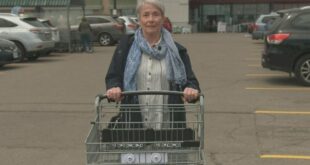Lawsuits over broken bones from slips on sidewalks have made it all the way to Canada’s top court.

On Jan. 6, 2015, Taryn Joy Marchi stepped through a snowbank next to a newly plowed parking spot in downtown Nelson and into a classic Canadian conundrum.
The ensuing drop injured Marchi’s leg badly enough to warrant $1 million in alleged damages.
The city claimed it had followed its snow removal policies, but could she sue them for a job poorly done?
Nine years later, the result of that question — a legal battle which made it all the way to the Supreme Court of Canada — continues to reverberate through the courts as well as the public works departments of cities across the country.
Especially on snowy days.
The question of a municipality’s ‘core policies’
In a nutshell, Marchi’s case dug into the question of a municipality’s “core policies” — decisions shielded from private negligence claims so the courts don’t create a “chilling effect” by subjecting all government decisions to legal liability.
On the day of Marchi’s injury, city crews removed snow from roads in Nelson — in the province’s southern Interior, about 423 kilometres east of Vancouver and 195 kilometres west of the border with Alberta — but they also cleared a series of angled parking spots in a main thoroughfare, creating a snowbank between street and sidewalk in the process.
Seeing no obvious way from parking stall to sidewalk, Marchi put her best foot froward — into the snowbank.

After a trial, a B.C. Supreme Court judge accepted the city’s claim that the entire snow removal process was covered by core policy immunity — a decision overturned by the B.C. Court of Appeal, which ordered a new trial.
The city appealed to the Supreme Court of Canada — which sided with Marchi, coming up with a legal test for judges to figure out what counts as a core policy, and what could be considered the kind of “operational implementation” that might be subject to a negligence claim.
“The City’s clearing of snow from the parking stalls … by creating snowbanks along the sidewalks — thereby inviting members of the public to park in those stalls — without ensuring direct access to sidewalks was not the result of a core policy decision immune from negligence liability,” the Supreme Court of Canada decision says.
“The public interest is not served when ad hoc decisions that fail to balance competing interests or that fail to consider how best to mitigate harms are insulated from liability in negligence.”

The decision doesn’t mean municipalities have no defence against snow injury lawsuits. But it does force the courts to apply stricter scrutiny if they try to point to their “policies” as a shield from liability.
“The mere presence of budgetary, financial, or resource implications does not determine whether a decision is core policy,” the decision says.
“Further, the fact that the word ‘policy’ is found in a written document, or that a plan is labelled as ‘policy’ may be misleading and is certainly not determinative of the question.”
Duelling responsibilities for homeowners
The City of Nelson also claimed that it had not breached the “standard of care expected that would be of an ordinary, reasonable and prudent person in the same circumstances.”
But the Supreme Court of Canada judges said a new trial would be needed to determine “factual findings regarding the impact of the evidence from other municipalities on the obligations imposed on the city.”
B.C.’s Appeal Court has also looked at the rights and responsibilities of pedestrians, homeowners and governments in another key case which emerged from a sidewalk slip.
In 2021, B.C.’s top court decided against a lawsuit filed by a Burnaby man who claimed damages against a couple whom he alleged had done a poor job of cleaning the sidewalk in front of their home, where he fell on black ice.
That case came down to duelling responsibilities for homeowners.
On the one hand, the court said they are bound by civil bylaws to clear sidewalks.
But as the judge who heard the case in the lower court pointed out, finding homeowners liable for injuries suffered because they did their civic duty the wrong way would mean “property owners would have an incentive not to make any efforts to comply with snow removal bylaws.”
The good neighbour principle
Underlying all these cases is another key legal principle concerning what it is to be a good neighbour.
The so-called neighbour principle was established in 1932 by the British House of Lords in a case involving a decomposed snail at the bottom of a bottle of ginger beer and a very surprised and unhappy customer.

“You must take reasonable care to avoid acts or omissions which you can reasonably foresee would be likely to injure your neighbour,” Lord James Atkin said at the time.
The courts have subsequently concluded that the good neighbour principle can only be extended so far.
“A homeowner has a duty to ensure that his or her own property is maintained in a reasonable condition so that persons entering the property are not injured,” the judge of a Toronto-based snow-clearing case found in 2000.
“The snow and ice accumulating on public sidewalks and the potholes on the street in front of the house are the legal responsibility of the municipality, not the adjacent property owner.”
ABOUT THE AUTHOR
Jason Proctor is a reporter in British Columbia for CBC News and has covered the B.C. courts and the justice system extensively.
*****
Credit belongs to : www.cbc.ca
 Atin Ito First Filipino Community Newspaper in Ontario
Atin Ito First Filipino Community Newspaper in Ontario






